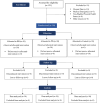Play dough or balloon blowing? A clinical trial comparing creative interventions for reducing preoperative anxiety in children aged 4-8 years
- PMID: 40375092
- PMCID: PMC12080033
- DOI: 10.1186/s12887-025-05718-1
Play dough or balloon blowing? A clinical trial comparing creative interventions for reducing preoperative anxiety in children aged 4-8 years
Abstract
Background: Preoperative anxiety is a significant concern for pediatric patients undergoing surgery, often leading to adverse physiological, emotional, and postoperative outcomes. Traditional pharmacological approaches, while effective, are associated with side effects, underscoring the need for age-appropriate non-pharmacological interventions. This study aimed to compare the effectiveness of play dough (PD) activities and balloon blowing (BB) in reducing preoperative anxiety in children.
Methods: This randomized controlled trial included 90 children aged 4-8 years, a developmental stage characterized by responsiveness to play-based interventions, scheduled for elective surgeries at Besat Hospital, Hamedan, Iran, between November 2023 and January 2025. Participants were randomized into three groups: PD, BB, and Control (standard care with midazolam). Anxiety levels were assessed at baseline (T0), immediately before entering the operating room (T1), and during anesthesia induction (T2) using the Modified Yale Preoperative Anxiety Scale (m-YPAS) and the Visual Analog Scale for Anxiety (VAS-A). Each intervention was administered for 15 min under direct supervision by a trained researcher. Statistical analysis included ANOVA for continuous variables and chi-square tests for categorical variables. Post hoc comparisons were performed using Tukey's method.
Results: At T1 and T2, children in the PD and BB groups exhibited significantly lower anxiety levels compared to the Control group (P < 0.001). For m-YPAS scores at T1, the PD group mean 36.05 ± 4.28, and the BB group 35.15 ± 2.94, compared to 54.55 ± 4.05 in the Control group. Similar trends were noted at T2. VAS-A analysis further supported these findings, with the PD and BB groups showing higher proportions of mild anxiety compared to the Control group. No significant differences were detected between the PD and BB groups, indicating that both interventions were comparably effective.
Conclusions: PD and BB are effective non-pharmacological interventions for reducing preoperative anxiety in children. These cost-effective, engaging techniques offer safe alternatives to pharmacological treatments and promote emotional well-being. The findings support integrating age-appropriate, creative, play-based strategies into pediatric surgical care, emphasizing their potential to enhance the preoperative experience and improve outcomes. Future research should investigate long-term impacts, applicability across diverse populations, and comparative efficacy in various clinical settings.
Trial registration: Registered in the Iranian registry of clinical trials ( https://irct.behdasht.gov.ir ) in 19/11/2023 with the following code: IRCT20230514058183N1.
Keywords: Balloon blowing; Non-pharmacological interventions; Pediatric surgery; Playdough; Preoperative anxiety.
© 2025. The Author(s).
Conflict of interest statement
Declarations. Ethics approval and consent to participate: This clinical trial was conducted in accordance with the ethical standards of the institutional and national research committee and with the 1964 Helsinki Declaration and its later amendments. The study was reviewed and approved by the Ethics Committee of Kermanshah University of Medical Sciences (ID: IR.KUMS.REC.1402.177) and was registered on the Iranian Registry of Clinical Trials (IRCT20230514058183N1). Written informed consent was obtained from the parents or legal guardians of all participating children aged 4–8 years after providing a clear explanation of the study’s objectives, procedures, and potential benefits. All data were anonymized, stored securely, and were only accessible to authorized members of the research team. This study adheres to the CONSORT guidelines for the reporting of randomized clinical trials. Consent for publication: Not applicable. Competing interests: The authors declare no competing interests. Phone: +989186855038.
Figures
Similar articles
-
The effect of play distraction on anxiety before premedication administration: a randomized trial.J Clin Anesth. 2017 Feb;36:27-31. doi: 10.1016/j.jclinane.2016.04.044. Epub 2016 Nov 2. J Clin Anesth. 2017. PMID: 28183568 Clinical Trial.
-
Utility of interactive videogame in allaying preoperative anxiety in pediatric surgical patients - A randomized controlled study.J Postgrad Med. 2024 Oct 1;70(4):198-203. doi: 10.4103/jpgm.jpgm_465_24. Epub 2024 Nov 29. J Postgrad Med. 2024. PMID: 39611402 Free PMC article. Clinical Trial.
-
Effectiveness of an App for Reducing Preoperative Anxiety in Children: A Randomized Clinical Trial.JAMA Pediatr. 2016 Aug 1;170(8):e160533. doi: 10.1001/jamapediatrics.2016.0533. Epub 2016 Aug 1. JAMA Pediatr. 2016. PMID: 27294708 Clinical Trial.
-
Folic acid supplementation and malaria susceptibility and severity among people taking antifolate antimalarial drugs in endemic areas.Cochrane Database Syst Rev. 2022 Feb 1;2(2022):CD014217. doi: 10.1002/14651858.CD014217. Cochrane Database Syst Rev. 2022. PMID: 36321557 Free PMC article.
-
The Role of Preoperative Virtual Reality for Anxiety Reduction in Pediatric Surgical Patients: A Systematic Review and Meta-Analysis.Cureus. 2025 Jan 7;17(1):e77077. doi: 10.7759/cureus.77077. eCollection 2025 Jan. Cureus. 2025. PMID: 39917152 Free PMC article. Review.
References
-
- Celik B, Canbulat Sahiner N. The effects of preoperative therapeutic play on anxiety and fear levels in preschool children. J Pediatr Nurs. 2024;78:e244–9. - PubMed
-
- Jovanovic K, Kalezic N, Sipetic Grujicic S, Zivaljevic V, Jovanovic M, Kukic B, et al. Preoperative anxiety is associated with postoperative complications in vascular surgery: A Cross-Sectional study. World J Surg. 2022;46(8):1987–96. - PubMed
Publication types
MeSH terms
LinkOut - more resources
Full Text Sources
Medical



